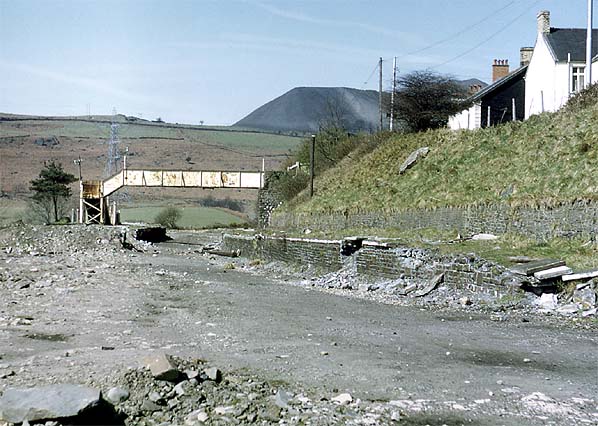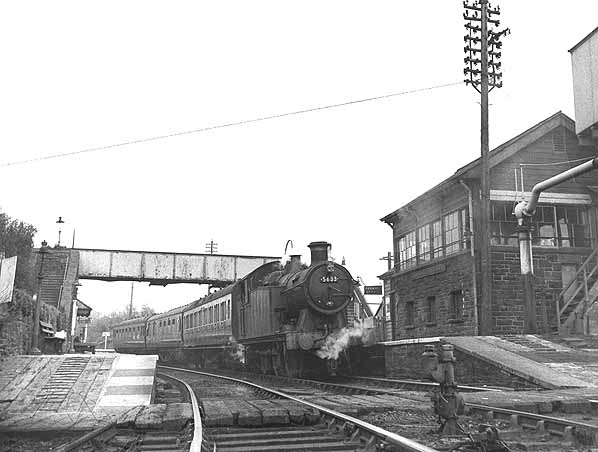|
Notes: The station was opened as Quakers Yard, 'High Level' was
added by 1890. The Low Level station is still open.
BRIEF HISTORY OF THE QUAKERS YARD AND MERTHYR JOINT RAILWAY
The Rhymney Railway was founded to transport minerals and materials to and from collieries and ironworks in the Rhymney Valley of South Wales, and to docks in Cardiff. It opened a main line in 1858, and a limited passenger service was operated in addition.
The first line was dependent on the cooperation of the parallel Taff Vale Railway (TVR) for part of the transit, and this relationship was uneasy; the Rhymney Railway built an independent line to Cardiff in 1871. Better relations were created with the London and North Western Railway (LNWR), and later the Great Western Railway (GWR), and two important joint lines with the GWR were built: the Taff Bargoed line (1876) and the Quakers Yard and Merthyr Joint line in 1882.
Quakers Yard was a very busy railway junction. It had three viaducts, the first was a six arch viaduct built by Brunel in 1840. It carried the Taff Valley Railway to Merthyr along the east bank of the River Taff. This viaduct is still in use today. Quakers Yard was also the junction between the Taff Valley Railway and the Taff Vale Extension (TWE) of the Newport, Abergavenny & Hereford Railway. This line passed over a second viaduct before entering a tunnel to reach the Cynon Valley below Aberdare from where it ran on to Neath and Swansea. With the arrival of the Rhymney Railway, this diverged from the TWE at Quakers Yard along the west bank of the River Taff. This required the building of a third viaduct, parallel to the second but curving away northwards towards Merthyr from it.
 Quakers Yard viaducts No 2 (foreground) and No 3. From Quakers Yard station a line passed over the second viaduct before entering a tunnel to reach the Cynon Valley below Aberdare from where it ran on to Neath and Swansea. The Rhymney Railway, later diverged from the Swansea line at Quakers Yard running along the west bank of the River Taff. This required the building of a third viaduct, parallel to the second but curving away northwards towards Merthyr from it. Both viaducts have now been demolished. Quakers Yard viaducts No 2 (foreground) and No 3. From Quakers Yard station a line passed over the second viaduct before entering a tunnel to reach the Cynon Valley below Aberdare from where it ran on to Neath and Swansea. The Rhymney Railway, later diverged from the Swansea line at Quakers Yard running along the west bank of the River Taff. This required the building of a third viaduct, parallel to the second but curving away northwards towards Merthyr from it. Both viaducts have now been demolished.
Photo
from John Mann collection Although the Rhymney Railway network was never large, it was remarkably profitable, and paid excellent dividends for most of its life. Dependent on mineral traffic for its own success, it declined in the 1970s, but the main line from Rhymney to Cardiff remains in heavy use as a local passenger line.
Although the GWR already had a presence at Merthyr through the Vale of Neath line, up to that point the Taff Vale Railway had a monopoly of the direct routes from Merthyr to the south and east.
 Now the Quakers Yard and Merthyr line was opened on 1 April 1886 from the Taff Vale Extension line at Quakers Yard running up the west side of the River Taff to Merthyr, ending at the GWR station there. Colliery and ironstone pit connections were made intermediately, and a branch line spur crossed the Taff to get access to the important Merthyr Vale colliery. The QY&MR Joint Line crossed the river Taff immediately after leaving Quakers Yard station. Now the Quakers Yard and Merthyr line was opened on 1 April 1886 from the Taff Vale Extension line at Quakers Yard running up the west side of the River Taff to Merthyr, ending at the GWR station there. Colliery and ironstone pit connections were made intermediately, and a branch line spur crossed the Taff to get access to the important Merthyr Vale colliery. The QY&MR Joint Line crossed the river Taff immediately after leaving Quakers Yard station.
There was already a railway running part of the way down the west bank: the private Gethin Railway belonging to the Cyfarthfa Ironworks, and this could be latched onto in the vicinity of Abercanaid, and a simple spur provided where it crossed the GWR Hirwain line to bring the joint trains into Merthyr High Street station.
The line opened for passenger traffic on 1 April 1886, trains using the High Street station at Merthyr. The new line crossed over the Taff Vale line and the Glamorganshire Canal shortly after leaving Quakers Yard GWR (later High Level) station, and at nearly 2 miles south there was a branch on the east side to the Merthyr Vale group of coal pits, crossing the river on a long steel viaduct. Initially there were only two intermediate stations at Aberfan and Abercanaid, with the service being worked by the Rhymney company. At Cyfarthfa Level Crossing Junction, where the spur to the former Vale of Neath line ran round Glyndyris Pond, the private Gethin Railway ran straight on to the Cyfarthfa Ironworks, with a branch to the east running up to the Ynys Fach works, and Rhymney goods trains and workmen's trains ran up to Cyfarthfa Furnace Tops.
The Taff Vale Railway introduced what it called "motor cars" (that is, railmotors) in 1905. These were single coaches incorporating a small steam engine integrated with the coach. The intention was to enable station calls at low-cost structures in rural areas. The Rhymney Railway observed the considerable success of the Taff Vale scheme, and in 1907 procured two such vehicles from Hudswell Clarke to its own design; the steam engine part was a small 0-4-0 tank engine with 3 ft 6 in wheels. The carriage part was supplied by Cravens. There were soon complaints of unsteady running, and a trailing axle was added to the locomotive unit, with 2 ft 9 in wheels.
One additional new station at Troedf-y-rhiw was opened on the Quakers Yard to Merthyr line on 18 February 1907 to make use make use of these 'cars' (renamed Troedf-y-rhiw Halt in 1924). The 'cars' were not a success; one was rebuilt in 1910, making a separate carriage and engine. The other was used until 1919 on the Penrhiwfelin workmen's train, and then modified in the same way as the other. Another new station, Pontygwaith Halt opened 11 September 1933. There were also a number of private and untimetabled stations for colliery workers. Gethin Pits Platform was in use between 1915 - 1928, , Castle Pit Platform was in use between 1897 - 1915. There was also a Merthyr Vale Miners Platform at the junction with the branch to the collieries.
Over the years, the second and third viaducts over the River Taff were affected by the underground movements of the coal workings of Deep Navigation Pit in Treharris, which travelled in a westerly direction. Even to this day there are still subsidence issues in Edwardsville. Both viaducts had timber reinforcements in their arches to make them safe but by the early 1950s the third viaduct became unsafe and this brought a premature termination termination of the passenger operation on the QY&M line in February 1951 with the closure of four stations and halts. The line was singled in 1952 but remained in use operated as a long siding from Merthyr. Aberfan station remained open to goods traffic until 1 November 1954 and track lifting at the southern end of the line began a year later. Coal wagons were stored along the line near Castle Pit into the mid-1950s and Abercanaid remained open until for goods traffic until 9 May 1960 although by this date it only handled coal. Although Troed-y-rhiw Halt closed to passengers in 1951 it was retained for use by mine workers until 1 November 1954. After the closure of Abercanaid to coal traffic the remaining track was quickly lifted. The third viaduct of the River Taff at Edwardsville was demolished in 1969.
Ticket from Michael Stewart, Route map drawn by Alan Young.
Sources:
See also: Pontygwaith Halt, Aberfan, Troedyrhiw Halt & Abercanaid
|




 Home Page
Home Page 



 Home Page
Home Page